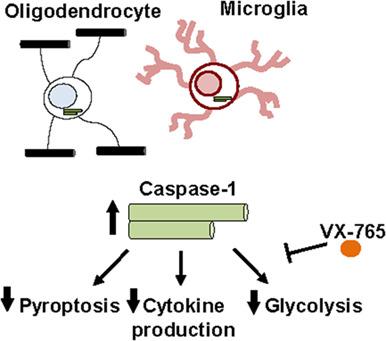Our official English website, www.x-mol.net, welcomes your
feedback! (Note: you will need to create a separate account there.)
Intranasal anti-caspase-1 therapy preserves myelin and glucose metabolism in a model of progressive multiple sclerosis.
Glia ( IF 5.4 ) Pub Date : 2020-09-03 , DOI: 10.1002/glia.23896 Leina B Saito 1 , Jason P Fernandes 1 , Mackenzie J Smith 2 , Matthew A L Doan 3 , William G Branton 2 , Laura M Schmitt 3, 4 , Melinda Wuest 5 , Maria C Monaco 6 , Eugene O Major 6 , Frank Wuest 5 , Christopher Power 1, 2, 3
Glia ( IF 5.4 ) Pub Date : 2020-09-03 , DOI: 10.1002/glia.23896 Leina B Saito 1 , Jason P Fernandes 1 , Mackenzie J Smith 2 , Matthew A L Doan 3 , William G Branton 2 , Laura M Schmitt 3, 4 , Melinda Wuest 5 , Maria C Monaco 6 , Eugene O Major 6 , Frank Wuest 5 , Christopher Power 1, 2, 3
Affiliation

|
Inflammatory demyelination and axonal injury in the central nervous system (CNS) are cardinal features of progressive multiple sclerosis (MS), and linked to activated brain macrophage‐like cells (BMCs) including resident microglia and trafficking macrophages. Caspase‐1 is a pivotal mediator of inflammation and cell death in the CNS. We investigated the effects of caspase‐1 activation and its regulation in models of MS. Brains from progressive MS and non‐MS patients, as well as cultured human oligodendrocytes were examined by transcriptomic and morphological methods. Next generation transcriptional sequencing of progressive MS compared to non‐MS patients' normal appearing white matter (NAWM) showed induction of caspase‐1 as well as other inflammasome‐associated genes with concurrent suppression of neuron‐specific genes. Oligodendrocytes exposed to TNFα exhibited upregulation of caspase‐1 with myelin gene suppression in a cell differentiation state‐dependent manner. Brains from cuprizone‐exposed mice treated by intranasal delivery of the caspase‐1 inhibitor, VX‐765 or its vehicle, were investigated in morphological and molecular studies, as well as by fluorodeoxyglucose‐positron emission tomography (FDG‐PET) imaging. Cuprizone exposure resulted in BMC and caspase‐1 activation accompanied by demyelination and axonal injury, which was abrogated by intranasal VX‐765 treatment. FDG‐PET imaging revealed suppressed glucose metabolism in the thalamus, hippocampus and cortex of cuprizone‐exposed mice that was restored with VX‐765 treatment. These studies highlight the caspase‐1 dependent interactions between inflammation, demyelination, and glucose metabolism in progressive MS and associated models. Intranasal delivery of an anti‐caspase‐1 therapy represents a promising therapeutic approach for progressive MS and other neuro‐inflammatory diseases.
中文翻译:

鼻内抗 caspase-1 疗法可在进行性多发性硬化症模型中保留髓磷脂和葡萄糖代谢。
中枢神经系统 (CNS) 的炎症性脱髓鞘和轴突损伤是进行性多发性硬化症 (MS) 的主要特征,并与活化的脑巨噬细胞样细胞 (BMC) 相关,包括常驻小胶质细胞和运输巨噬细胞。Caspase-1 是中枢神经系统炎症和细胞死亡的关键介质。我们研究了 caspase-1 激活的影响及其在 MS 模型中的调节。通过转录组学和形态学方法检查了来自进行性 MS 和非 MS 患者的大脑,以及培养的人类少突胶质细胞。与非 MS 患者的正常白质 (NAWM) 相比,进行性 MS 的下一代转录测序显示 caspase-1 以及其他炎症小体相关基因的诱导,同时神经元特异性基因的抑制。暴露于 TNFα 的少突胶质细胞以细胞分化状态依赖的方式表现出 caspase-1 的上调和髓鞘基因抑制。在形态学和分子研究以及氟脱氧葡萄糖-正电子发射断层扫描 (FDG-PET) 成像中研究了通过鼻内递送 caspase-1 抑制剂 VX-765 或其载体处理的铜宗暴露小鼠的大脑。Cuprizone 暴露导致 BMC 和 caspase-1 激活,并伴有脱髓鞘和轴突损伤,经鼻内 VX-765 治疗消除了这种情况。FDG-PET 成像显示暴露于铜酮的小鼠的丘脑、海马和皮质中的葡萄糖代谢受到抑制,这些小鼠通过 VX-765 治疗得以恢复。这些研究强调了炎症、脱髓鞘、和进行性 MS 和相关模型中的葡萄糖代谢。抗 caspase-1 疗法的鼻内给药代表了一种有前途的治疗进行性 MS 和其他神经炎症疾病的方法。
更新日期:2020-11-12
中文翻译:

鼻内抗 caspase-1 疗法可在进行性多发性硬化症模型中保留髓磷脂和葡萄糖代谢。
中枢神经系统 (CNS) 的炎症性脱髓鞘和轴突损伤是进行性多发性硬化症 (MS) 的主要特征,并与活化的脑巨噬细胞样细胞 (BMC) 相关,包括常驻小胶质细胞和运输巨噬细胞。Caspase-1 是中枢神经系统炎症和细胞死亡的关键介质。我们研究了 caspase-1 激活的影响及其在 MS 模型中的调节。通过转录组学和形态学方法检查了来自进行性 MS 和非 MS 患者的大脑,以及培养的人类少突胶质细胞。与非 MS 患者的正常白质 (NAWM) 相比,进行性 MS 的下一代转录测序显示 caspase-1 以及其他炎症小体相关基因的诱导,同时神经元特异性基因的抑制。暴露于 TNFα 的少突胶质细胞以细胞分化状态依赖的方式表现出 caspase-1 的上调和髓鞘基因抑制。在形态学和分子研究以及氟脱氧葡萄糖-正电子发射断层扫描 (FDG-PET) 成像中研究了通过鼻内递送 caspase-1 抑制剂 VX-765 或其载体处理的铜宗暴露小鼠的大脑。Cuprizone 暴露导致 BMC 和 caspase-1 激活,并伴有脱髓鞘和轴突损伤,经鼻内 VX-765 治疗消除了这种情况。FDG-PET 成像显示暴露于铜酮的小鼠的丘脑、海马和皮质中的葡萄糖代谢受到抑制,这些小鼠通过 VX-765 治疗得以恢复。这些研究强调了炎症、脱髓鞘、和进行性 MS 和相关模型中的葡萄糖代谢。抗 caspase-1 疗法的鼻内给药代表了一种有前途的治疗进行性 MS 和其他神经炎症疾病的方法。











































 京公网安备 11010802027423号
京公网安备 11010802027423号